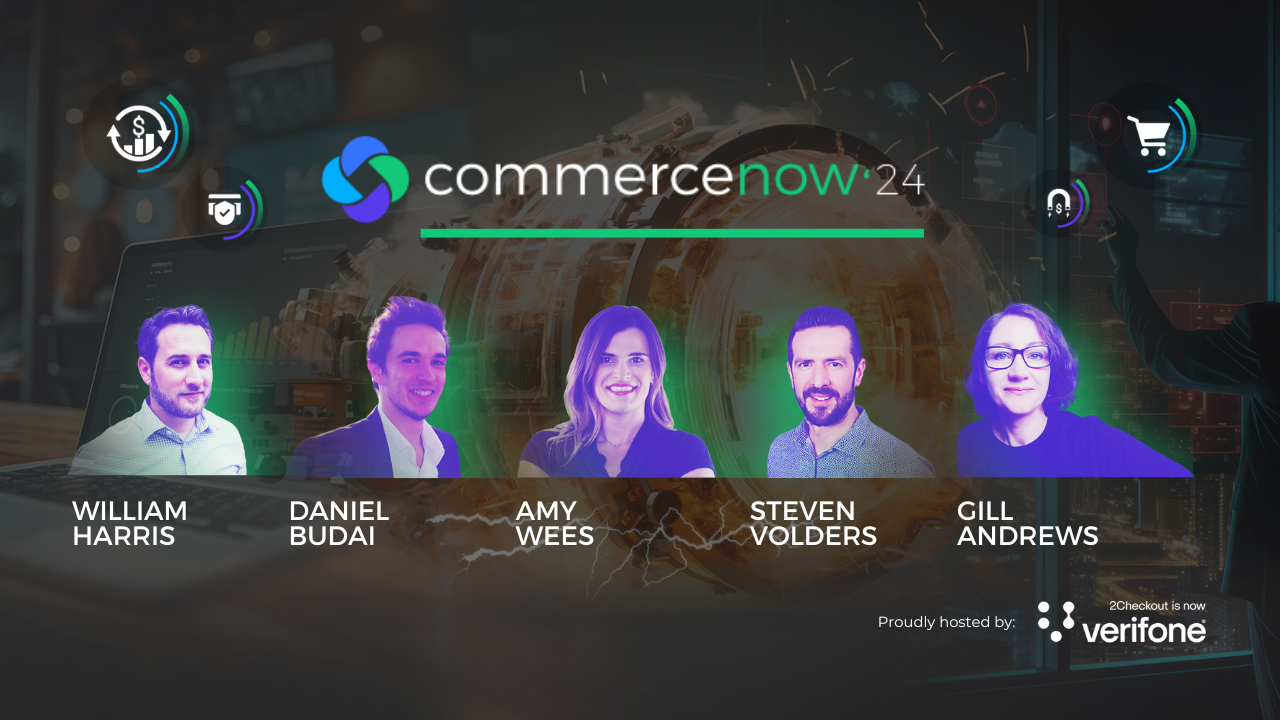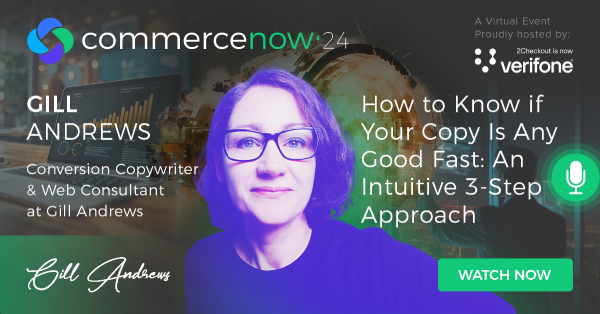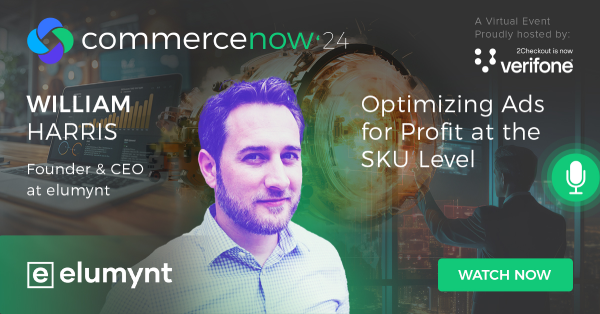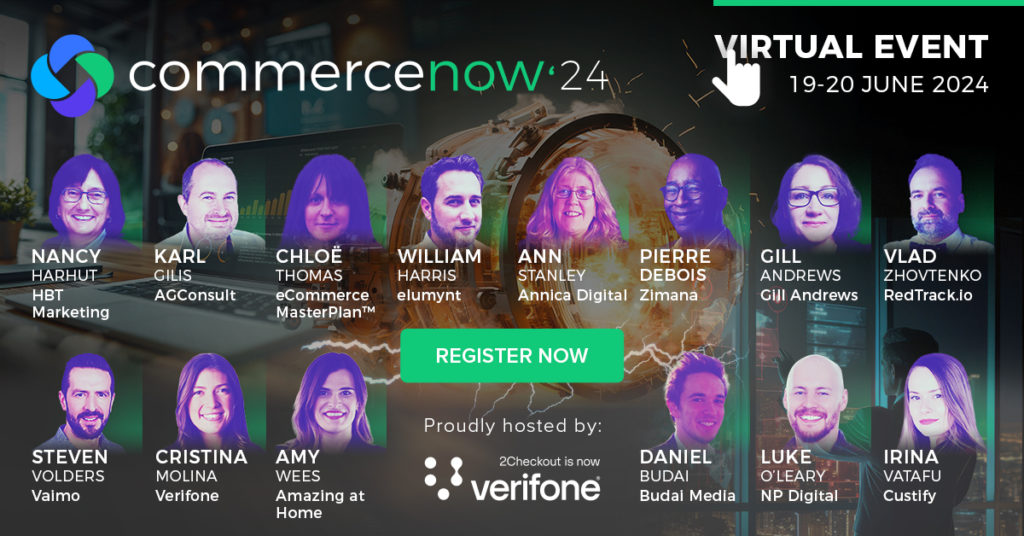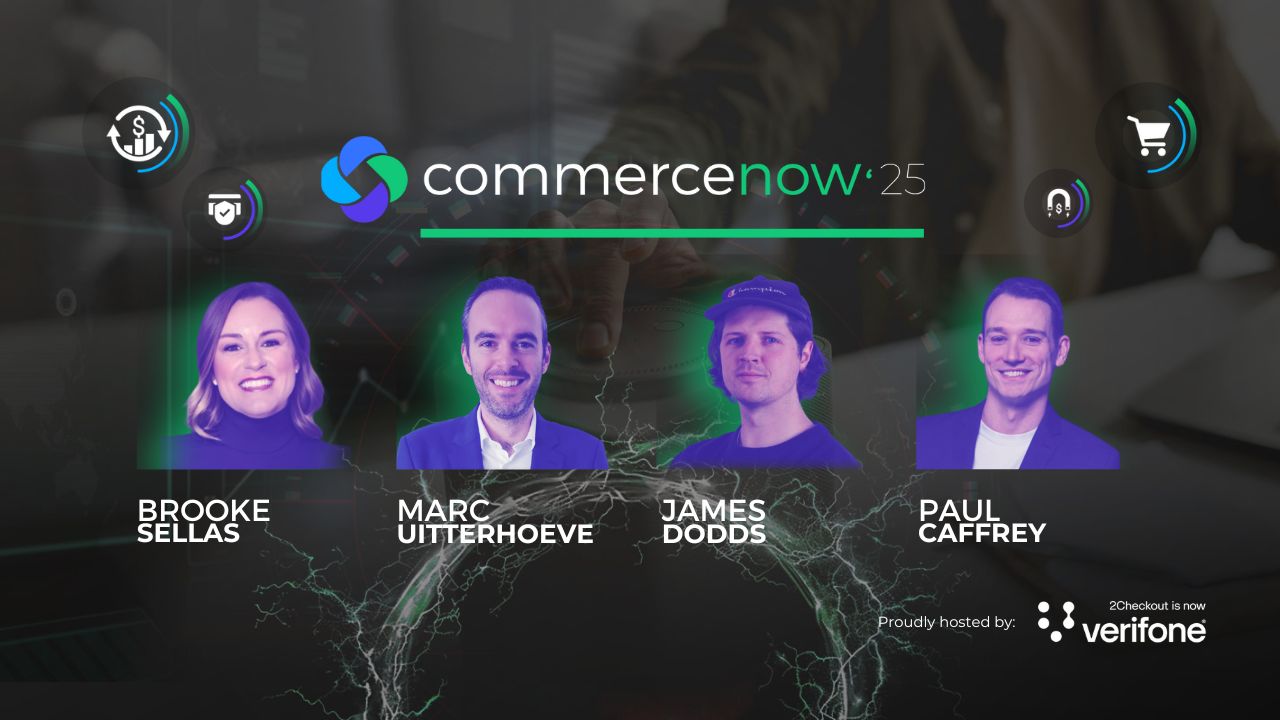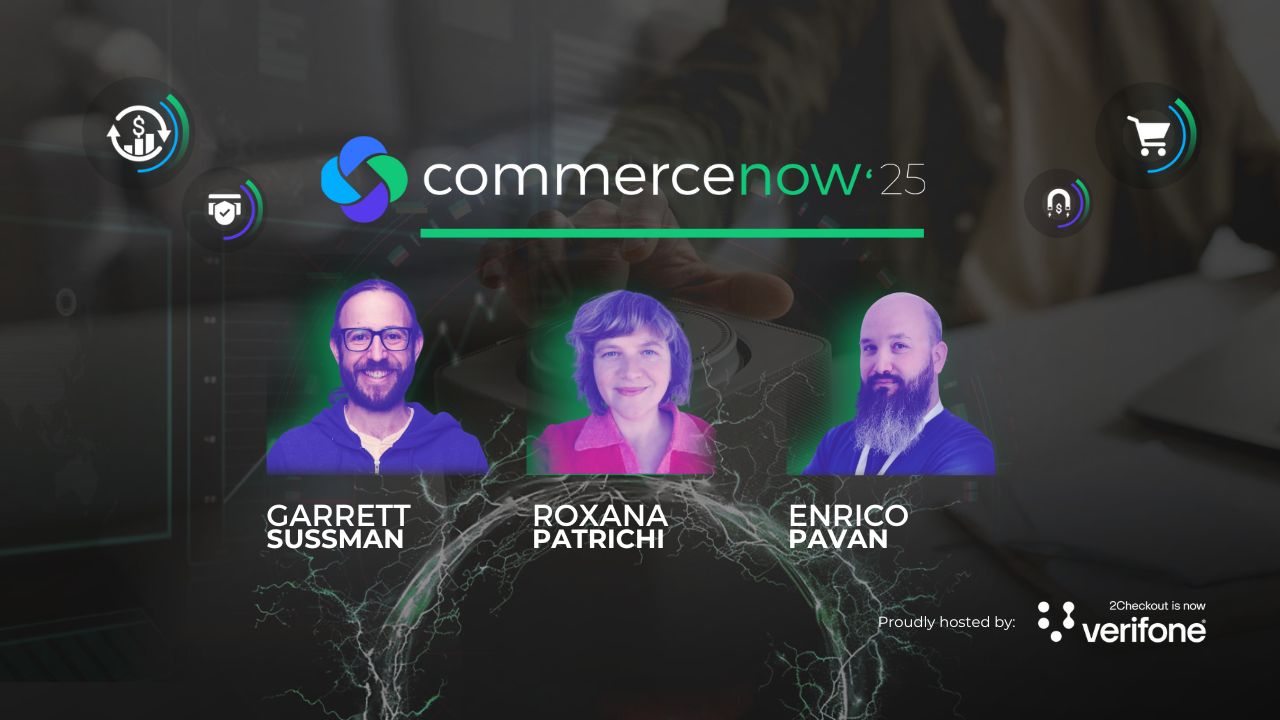CommerceNow 2024 brought fresh, practical ideas to the world of e-commerce, straight from the experts.
This year’s event focused on real strategies that businesses can use right now—from creating website copy that converts and leveraging the power of AI to boost ad results, to crafting engaging emails and delivering personalized experiences to a growing audience.
Featuring insights from experts Gill Andrews, Amy Wees, William Harris, Daniel Budai, and Steven Volders, these sessions provide clear, actionable steps to help businesses improve their approach to e-commerce.
Key highlights include:
- Practical methods to evaluate and improve your copy,
- Using AI to drive brand and product development,
- Advanced metrics for profitable ad spend,
- Strategies for writing engaging email campaigns, and
- Effective approaches to personalize customer experiences across all channels.
Dive below for the expert advice and hands-on strategies shared in each session.
Create Web Copy and Emails That Connect & Convert
How To Make Your Website Copy Work Harder
Gill Andrews shares a straightforward, three-step approach to help non-copywriters assess their copy with confidence.
Her process is fairly simple, focusing on essential steps that make a real difference: understanding the audience, ensuring clarity, and addressing common missteps.
Know Your Audience
Gill highlights the importance of knowing exactly who you’re speaking to—what your audience needs, what they care about, and how familiar they are with your product.
She suggests building a clear picture of your ideal customer, covering details like age, interests, and what motivates them to buy.
It’s also crucial to consider how much your audience already knows about the problem, your solution, and your brand. Without this foundation, the copy risks feeling irrelevant or unclear.
Engage with Empathy
Gill stresses that copy should feel conversational, speaking to the reader’s interests and emotions. She introduces three intuitive reactions that can serve as a quick test of copy quality:
- “Huh?” – This means the reader is confused. They’re unsure what you’re trying to say, and the message isn’t clear.
- “Prove it!” – This reaction shows doubt. The reader finds the claim hard to believe, often because it lacks evidence.
- “So what?” – This suggests indifference. The reader doesn’t see why the information matters to them or what value it offers.
These reactions help spot problem areas, like jargon, vague statements, or claims that lack proof. By tackling these issues, businesses can make their copy feel clear, reliable, and genuinely focused on the customer.
Apply Simple Fixes
Based on the reactions above, Gill suggests practical tweaks to make copy more effective. For example, if a sentence seems confusing, she recommends breaking it down or rephrasing it in straightforward language. Industry terms or jargon can be simplified or briefly explained to avoid losing the reader’s attention.
When a claim sounds too bold or unsupported, adding specifics can make it more credible—like including a statistic, testimonial, or example to back it up.
For instance, instead of saying, “We provide a number of services,” a more specific line like “We offer three main services: web design, SEO, and digital marketing strategy” answers the reader’s questions right away.
These small tweaks turn vague or cluttered copy into a clear, compelling message that’s easier for customers to trust and act on.
Get access to more of Gill’s insights by watching his entire CommerceNow 2024 session.
Email Campaigns That Keep Your Readers Hooked
Daniel Budai, an expert in e-commerce email marketing, highlights how tailored email strategies can boost both engagement and retention.
Drawing on insights from hundreds of email audits, he shares practical steps to make email campaigns stand out and perform better:
Create a Campaign Calendar
To keep things organized and consistent, Daniel recommends setting up a detailed email campaign calendar. This should outline when each email goes out, what type it is (like sales, content, or trust-building), which segments it targets, and any A/B tests planned.
With a calendar, the whole team stays aligned, and every email has a clear goal. Without this structure, brands risk missed opportunities and sending mixed messages that can confuse or disengage subscribers.
Segment Your Audience with Purpose
A core part of Daniel’s strategy is segmentation, meaning you group subscribers based on specific traits—like location, purchase history, or engagement level.
For example, a brand with an international reach might send location-based messages, while e-commerce businesses can use purchase history to recommend relevant products.
He also suggests segmenting by engagement level, like targeting those who have interacted recently, so the most active subscribers get more frequent emails.
Balance Content and Sales Messages
Daniel warns that a steady stream of sales emails can quickly overwhelm subscribers. Instead, he advises a balance—roughly 50% content emails and 50% promotions. Sharing useful information, industry updates, or product tips helps build trust and keeps readers interested.
He gives examples like sending out niche-relevant jokes, surveys, or helpful articles that can drive engagement without feeling too sales-focused.
Brands that mainly send promotional emails, he notes, tend to see lower open rates as subscribers lose interest.
Run Structured Sales Events
For monthly promotions, Daniel suggests a structured approach that starts with a teaser email, followed by a grand opening announcement, and then a series of reminders as the event closes.
Tip from Daniel: To add urgency, send plain-text reminders or SMS messages in the last day or two, which can drive up conversions.
For example, brands might begin with a pre-event teaser, then follow up with a launch email, and wrap up with last-chance reminders. This approach keeps your audience engaged and encourages them to take action.
By following these strategies, businesses can create email campaigns that capture subscriber attention and lead to higher conversions over time.
To watch Daniel’s full talk, make sure to visit the dedicated session page.
Use AI to Drive Brand Innovation and Stand Out
Amy Wees offers an exciting look at how AI tools are reshaping product development and branding. With tools like ChatGPT and MidJourney, brands can create fresh ideas, design eye-catching visuals, and adapt quickly to market trends— all without needing massive resources.
Here’s how Amy breaks it down:
Find Market Gaps and Spark Fresh Ideas
AI is a powerful brainstorming partner. By scanning trends and analyzing competitors, it helps brands discover what’s missing in the market.
Amy explains that AI can:
- Identify market gaps: AI tools reveal unmet needs, like a rising demand for eco-friendly materials or minimalist designs.
- Develop ideas that resonate: By showing what consumers value, AI helps brands create products that feel fresh and relevant.
- Reduce guesswork: With AI’s data-driven insights, brands can fine-tune ideas early in the process, saving time and increasing the likelihood of success.
Create Brand Visuals that Make an Impact
AI is also transforming how brands create visuals. Amy points out that with tools like MidJourney, brands can quickly test logo designs, product packaging, and other assets that reflect their identity.
Key benefits include:
- Fast prototyping: AI makes it affordable and quick to try out different design ideas, helping brands find what clicks with their audience.
- True to brand values: From logo colors to packaging textures, AI helps design assets that authentically represent the brand’s mission and appeal to the audience.
Keep a Step Ahead of Competitors
AI keeps brands in the loop on what competitors are up to, from pricing adjustments to shifts in customer sentiment.
Amy shares how brands can use AI to:
- Monitor market trends in real-time: AI tools track competitor changes and customer feedback, helping brands respond quickly to new developments.
- Spot competitors’ weaknesses: By analyzing competitor reviews, AI can reveal common complaints, giving brands the opportunity to address these issues in their own offerings.
- Refine positioning: With a clear view of the competitive landscape, brands can adjust their messaging and features to stand out.
A Few Real-World Applications
Amy discusses practical ways brands can use AI to streamline their processes, including:
- Generating realistic product mockups: Ideal for testing ideas without a full production run.
- Assisting with keyword research and content ideas: AI supports SEO efforts by pinpointing popular keywords and relevant content topics.
- Analyzing customer feedback for product improvements: For instance, a skincare brand might use AI to track trending ingredients or analyze reviews, ensuring new products align with customer expectations.
With AI in their toolkit, brands can keep up with the fast-moving market, bring bold ideas to life, and stay one step ahead of the competition – more efficiently than ever.
Learn how to drive brand innovation and stand out by watching Amy Wees’ full session here.
Make the Most of Data to Maximize Ad Spend and Boost Profits
When it comes to ad spend, every dollar counts. William Harris reveals how brands can go beyond surface-level metrics to make smarter, data-backed decisions that turn ad budgets into real, measurable profits.
William shares a three-part strategy to getting the most from your ad spend:
Focus on Metrics That Matter
He highlights three powerful metrics that help brands see beyond surface-level ad performance:
- ROAS (Return on Ad Spend): ROAS shows how much revenue you earn for every dollar spent on ads. William recommends tracking ROAS not just for the overall campaign, but right down to each product. This way, brands know exactly which items are pulling their weight.
- MER (Marketing Efficiency Ratio): MER provides a big-picture view, comparing total revenue to all marketing costs. It helps brands understand if their entire marketing strategy—not just a single ad—is delivering value.
- LTV to CAC (Customer Lifetime Value to Customer Acquisition Cost): This ratio compares the long-term value of a customer to what it costs to bring them on board. William explains that a high LTV to CAC ratio means customers are bringing in more value over time, making growth sustainable.
Avoid These Ad Spend Traps
William shares some common pitfalls to watch out for:
- Getting Stuck on ROAS Alone: While ROAS is important, William warns that fixating on it can mean missing the bigger picture. He advises balancing ROAS with MER to get a complete view of profitability.
- Overspending on New Customers: It’s tempting to go all-in on acquiring new customers, but if acquisition costs soar, profits can take a hit. William suggests keeping a close eye on how much value each new customer adds over time (LTV) to ensure growth stays balanced.
Build Campaigns for Lasting Results
William’s provides the tips below for structuring ad campaigns to help brands get the most out of their budget:
- Start Small and Experiment: Begin with a smaller budget to test performance before scaling up. By trying different audiences, ad copy, and visuals, brands can zero in on what works best.
- Double Down on Winners: Once brands spot their best-performing ads, it’s time to give these more budget. Focusing on the top performers maximizes ROI without unnecessary spending.
- Check In Regularly: William suggests reviewing metrics weekly. This lets brands stay agile, tweaking campaigns to match shifting trends and customer behavior.
By focusing on the right metrics and refining their approach, brands can make every ad dollar work harder, supporting long-term, profitable growth.
For more tips on maximizing ad spend and boosting profits, make sure to watch William Harris’ full session here.
Use Personalization to Drive Deeper Customer Connections
Steven Volders discusses how brands can make every interaction count by delivering personalized experiences that feel one-on-one—even when reaching thousands.
Here’s his blueprint for creating personalization that keeps customers coming back:
Start Small and Grow Your Personalization Efforts
Steven recommends a phased approach to personalization:
- Phase 1: Focus on One Channel – Begin with a single-channel approach, like personalized emails. This lets brands test the waters, experimenting with tailored content without overwhelming their team or budget.
- Phase 2: Sync Across Channels – Once single-channel personalization is in place, it’s time to align it across email, website, and social media. This way, customers get a consistent, seamless experience no matter where they interact with the brand.
- Phase 3: Go Full Scale – In this final phase, brands personalize every interaction across all channels. Think tailored recommendations, real-time adjustments, and individualized offers that adapt to each user’s journey.
Build a Complete Picture of Each Customer Using CDP
A key to effective personalization is knowing your customer inside and out. Steven explains that brands should pull data from every interaction—whether it’s from browsing behavior, purchase history, or support chats.
To achieve this at scale, Steven recommends using Customer Data Platforms (CDPs), which consolidate customer data into a single, clear profile.
With CDPs, businesses can automate personalized experiences that consistently align with each customer’s unique preferences, ensuring interactions remain both relevant and valuable.
Automate to Keep Up with Demand
As personalization becomes more complex, Steven emphasizes the importance of automation. AI and machine learning enable brands to deliver tailored experiences at scale, adjusting content in real time based on each customer’s actions.
Automated systems ensure that as a brand’s audience grows, personalization remains consistent and impactful.
Get tips on building stronger customer connections—watch Steven Volders’ full session here.
What’s Next? Discover More with CommerceNow’24
The insights shared here only scratch the surface.
If you’re ready to dig deeper and uncover what’s shaping the future of digital commerce, don’t miss the full sessions from CommerceNow’24.
Join thought leaders like Steven Volders, Gill Andrews, Amy Wees, William Harris, and Daniel Budai as they reveal strategies to elevate your approach and drive real growth.
Watch the CommerceNow’24 webinars now.

